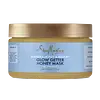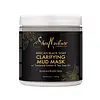What's inside
What's inside
 Key Ingredients
Key Ingredients

 Benefits
Benefits

 Concerns
Concerns

 Ingredients Side-by-side
Ingredients Side-by-side

Water
Skin ConditioningHoney
HumectantGlycerin
HumectantHydrogenated Vegetable Oil
EmollientRicinus Communis Seed Oil
MaskingCarthamus Tinctorius Seed Oil
MaskingGlyceryl Caprylate
EmollientXanthan Gum
EmulsifyingButyrospermum Parkii Butter
Skin ConditioningHydrogenated Ethylhexyl Olivate
EmollientAllantoin
Skin ConditioningSalicylic Acid
MaskingYogurt Powder
Hydrogenated Olive Oil Unsaponifiables
EmollientTetrahexyldecyl Ascorbate
AntioxidantInulin
Skin ConditioningMica
Cosmetic ColorantTitanium Dioxide
Cosmetic ColorantTin Oxide
AbrasiveGlyceryl Undecylenate
EmollientWater, Honey, Glycerin, Hydrogenated Vegetable Oil, Ricinus Communis Seed Oil, Carthamus Tinctorius Seed Oil, Glyceryl Caprylate, Xanthan Gum, Butyrospermum Parkii Butter, Hydrogenated Ethylhexyl Olivate, Allantoin, Salicylic Acid, Yogurt Powder, Hydrogenated Olive Oil Unsaponifiables, Tetrahexyldecyl Ascorbate, Inulin, Mica, Titanium Dioxide, Tin Oxide, Glyceryl Undecylenate
Water
Skin ConditioningKaolin
AbrasiveBentonite
AbsorbentSimmondsia Chinensis Seed Oil
EmollientSulfur
AntiseborrhoeicEmulsifying Wax Nf
Butyrospermum Parkii Butter
Skin ConditioningSodium Stearoyl Lactylate
EmulsifyingButyl Avocadate
Skin ConditioningSalix Alba Bark Extract
AstringentGlycerin
HumectantBenzyl PCA
HumectantSalicylic Acid
MaskingPhytosterols
Skin ConditioningPanthenol
Skin ConditioningAscorbic Acid
AntioxidantTocopherol
AntioxidantBisabolol
MaskingMelaleuca Alternifolia Leaf Oil
AntioxidantDehydroacetic Acid
PreservativeAllantoin
Skin ConditioningTamarindus Indica Extract
SmoothingOlea Europaea Fruit Oil
MaskingMentha Spicata Flower/Leaf/Stem Oil
MaskingMentha Piperita Oil
MaskingEucalyptus Globulus Oil
Water, Kaolin, Bentonite, Simmondsia Chinensis Seed Oil, Sulfur, Emulsifying Wax Nf, Butyrospermum Parkii Butter, Sodium Stearoyl Lactylate, Butyl Avocadate, Salix Alba Bark Extract, Glycerin, Benzyl PCA, Salicylic Acid, Phytosterols, Panthenol, Ascorbic Acid, Tocopherol, Bisabolol, Melaleuca Alternifolia Leaf Oil, Dehydroacetic Acid, Allantoin, Tamarindus Indica Extract, Olea Europaea Fruit Oil, Mentha Spicata Flower/Leaf/Stem Oil, Mentha Piperita Oil, Eucalyptus Globulus Oil
 Reviews
Reviews

Ingredients Explained
These ingredients are found in both products.
Ingredients higher up in an ingredient list are typically present in a larger amount.
Allantoin is a soothing ingredient known for its protective and moisturizingg properties. Because of this, it is often added to products with strong active ingredients.
Studies show higher concentrations of this ingredient can promote wound healing.
Though it can be derived from the comfrey plant, allantoin is produced synthetically for cosmetic products to ensure purity.
Learn more about AllantoinThis ingredient is also known as shea butter. It is an effective skin hydrator and emollient.
Emollients help soothe and soften your skin. It does this by creating a protective film on your skin. This barrier helps trap moisture and keeps your skin hydrated. Emollients may be effective at treating dry or itchy skin.
Shea butter is rich in antioxidants. Antioxidants help fight free-radicals, or molecules that may harm the body. It is also full of fatty acids including stearic acid and linoleic acid. These acids help replenish the skin and keep skin moisturized.
While Shea Butter has an SPF rating of about 3-4, it is not a sunscreen replacement.
Shea butter may not be fungal acne safe. We recommend speaking with a professional if you have any concerns.
Learn more about Butyrospermum Parkii ButterGlycerin is already naturally found in your skin. It helps moisturize and protect your skin.
A study from 2016 found glycerin to be more effective as a humectant than AHAs and hyaluronic acid.
As a humectant, it helps the skin stay hydrated by pulling moisture to your skin. The low molecular weight of glycerin allows it to pull moisture into the deeper layers of your skin.
Hydrated skin improves your skin barrier; Your skin barrier helps protect against irritants and bacteria.
Glycerin has also been found to have antimicrobial and antiviral properties. Due to these properties, glycerin is often used in wound and burn treatments.
In cosmetics, glycerin is usually derived from plants such as soybean or palm. However, it can also be sourced from animals, such as tallow or animal fat.
This ingredient is organic, colorless, odorless, and non-toxic.
Glycerin is the name for this ingredient in American English. British English uses Glycerol/Glycerine.
Learn more about GlycerinSalicylic Acid (also known as beta hydroxy acid or BHA) is a well-known ingredient for treating skin that struggles with acne and clogged pores. It exfoliates both the skin's surface and deep within the pores to help clear out buildup, control oil, and reduce inflammation.
Unlike AHAs (alpha hydroxy acids), salicylic acid is oil-soluble. This allows it to penetrate into pores which makes it especially effective for treating blackheads and preventing future breakouts.
Salicylic acid is also known for its soothing properties. It has a similar structure to aspirin and can calm inflamed or irritated skin, making it a good option for acne-prone skin that is also sensitive.
Concentrations of 0.5-2% are recognized by the U.S. FDA as an over-the-counter topical acne product.
It can cause irritation and/or dryness if one's skin already has a compromised moisture barrier, so it's best to focus on repairing that before introducing this ingredient into your routine.
While salicylic acid does not increase sun sensitivity, it’s still important to wear sunscreen daily to protect your skin.
If you are looking for the ingredient called BHA or Butylated Hydroxyanisole, click here.
Learn more about Salicylic AcidWater. It's the most common cosmetic ingredient of all. You'll usually see it at the top of ingredient lists, meaning that it makes up the largest part of the product.
So why is it so popular? Water most often acts as a solvent - this means that it helps dissolve other ingredients into the formulation.
You'll also recognize water as that liquid we all need to stay alive. If you see this, drink a glass of water. Stay hydrated!
Learn more about Water